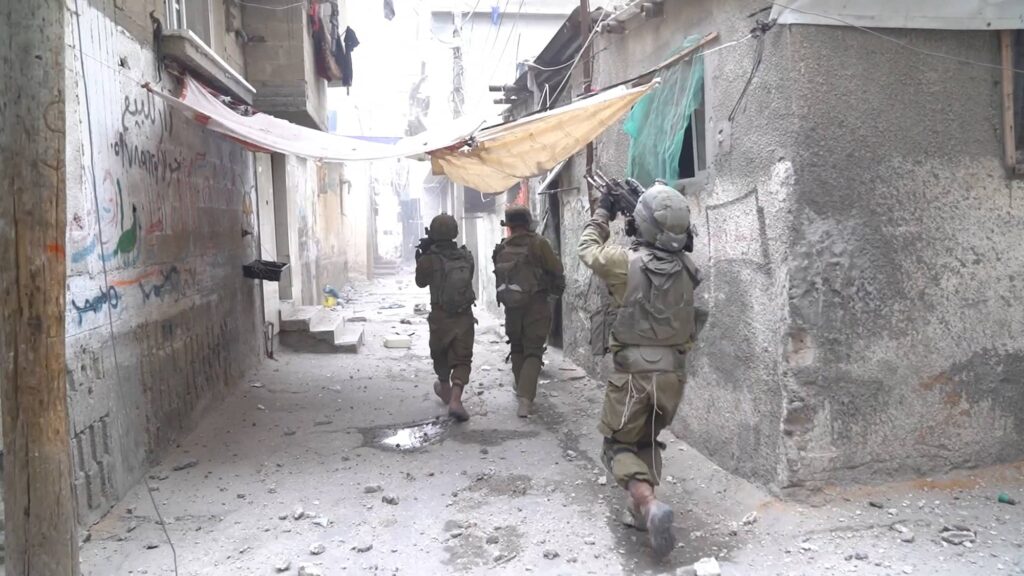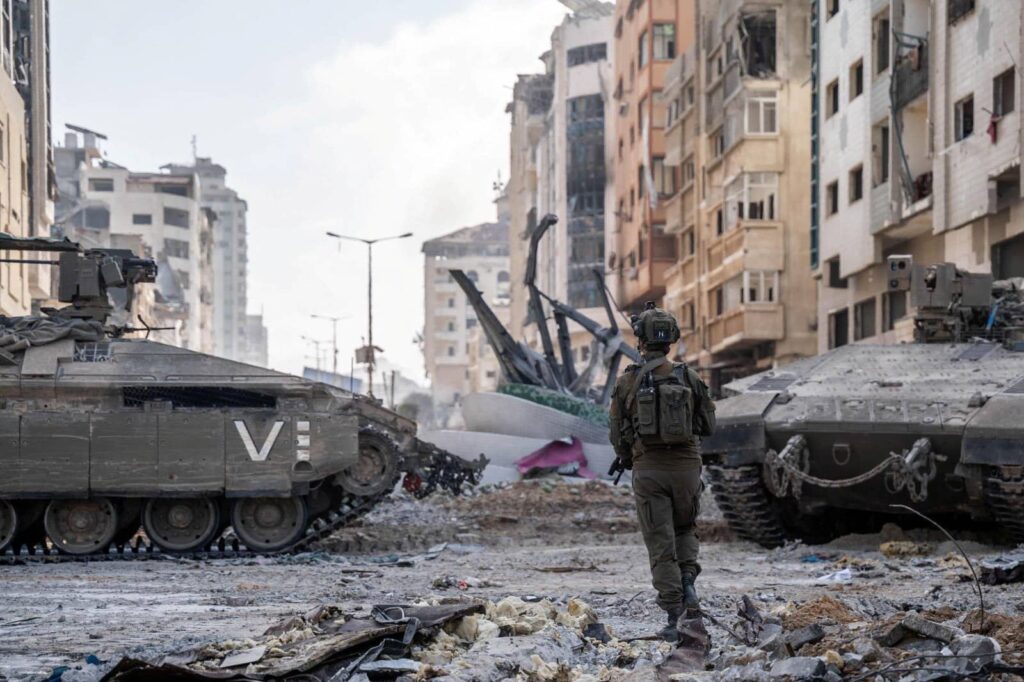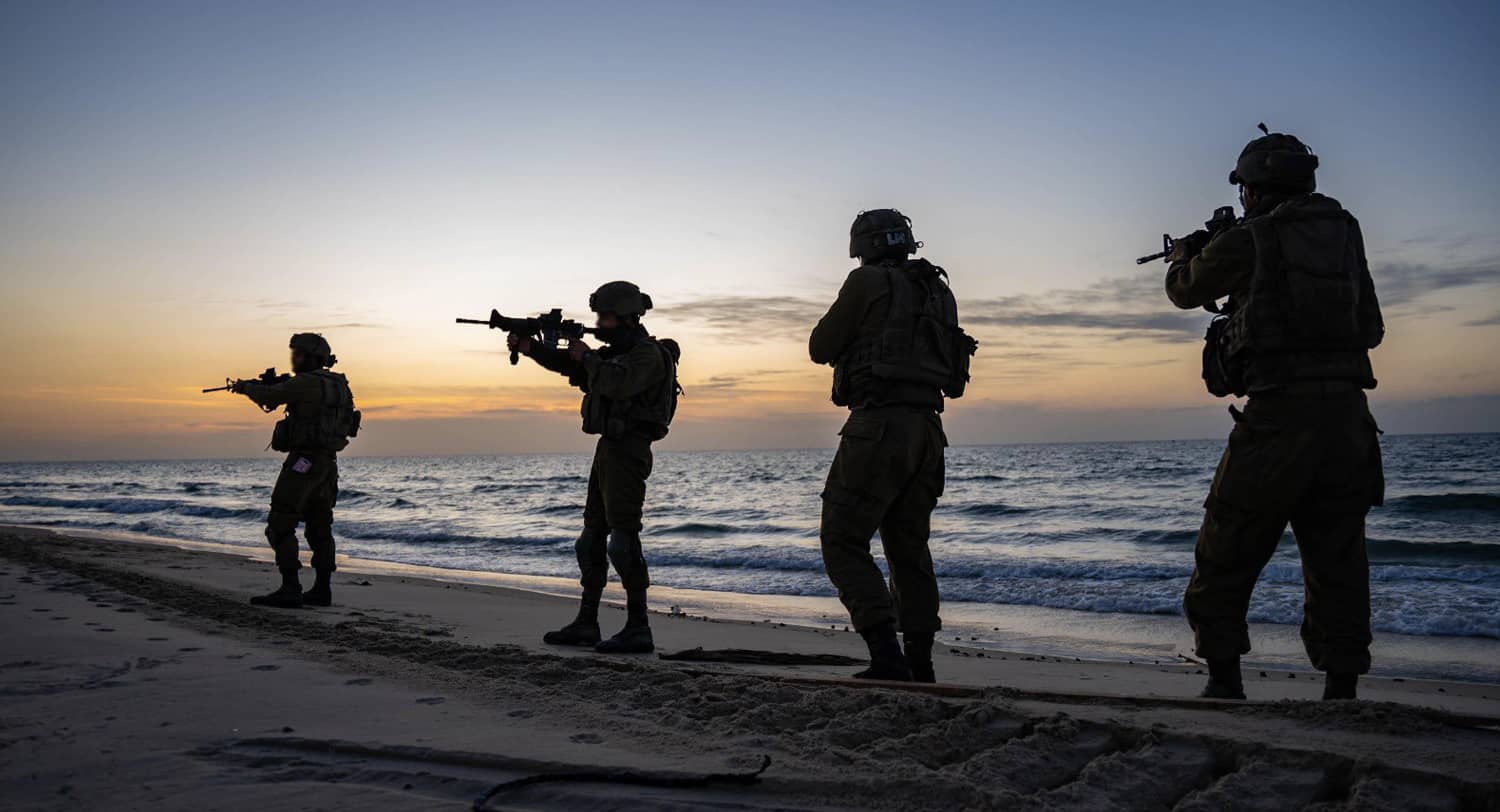On Saturday, November 18, Israel’s war in Gaza reached its 43rd day and the ground offensive in Gaza has now reached its three-week mark. This war, Israel’s leaders say, is going to be long. But we are beginning to see the ground offensive reach a new phase.
>> Reports from the Gaza Front: Read more from Seth J. Frantzman
To date, 56 IDF troops have been killed in the ground campaign, four hostages have been released by Hamas, and one was freed by the IDF. This week, three more hostages have been reported as killed. The IDF recovered the bodies of Israeli civilian Yehudit Weiss and Corporal Noa Marciano near the Shifa Hospital. A Tanzanian student named Clemens Felix Matanga, kidnapped by Hamas on October 7, was announced killed in Gaza over the weekend. There are concerns for a fourth, elderly hostage after Hamas released a video claiming he was dead.
On Thursday, November 16, Israel’s Minister of Defense Yoav Gallant traveled to the headquarters of the 36th division (nicknamed “rage”). Historically assigned to the Golan front in the north, it is now the division tasked with splitting Gaza in half by slicing through an area south of Gaza City. This area is relatively unpopulated, consisting of fields and open land and some suburban communities. The division raced to the sea this week. Gaza City and its environs were then encircled. At the same time, the 13th and 51st infantry battalions of the Golani Brigade helped get to the beach and secured the southern part of the encirclement. The special significance of these Golani battalions is that they were guarding the Gaza border on October 7 and suffered heavy casualties. Now they were taking the fight to the enemy, showing that Hamas could not shatter them or their morale.
Gallant went down to the 36th division to hammer home the success he believes Israel is having in Gaza. The division had also helped secure Shifa Hospital, Gaza’s largest hospital. This is in the international spotlight because the hospital is alleged to have a Hamas command center underneath it. Israel has provided some evidence of weapons at the hospital compound, but it appears that no Hamas commanders were still there, and that hostages held beneath it were removed elsewhere (or as indicated above, killed).
“We have gained operational control of the western region of Gaza City; “ Gallant told the troops, “we are heading into the next phase of the [ground] operations. The further we take this operation, [the more we] increase the pressure on Hamas and succeed in eliminating their terror infrastructure including headquarters and tunnels, while also taking down [Hamas] leadership and operatives.”
I’ve been back and forth to the border of Gaza since the first day of the war. Over the last week, I visited an artillery unit. This is the 215th brigade which uses M109 self-propelled howitzers to support operations in Gaza. It supports the operations of the 162nd Division. This Division is completing the encirclement of Gaza City from the north. Think of the 36th Division south of the city as the hammer and the 162nd as the anvil, or two pincers moving toward each other. The divisions also operate along the coast. They took the harbor of Gaza this week and the 162nd took the neighborhood of Shati Camp.
Shati is a refugee camp established in 1948. Historically many Palestinian refugee camps were centers of political activism and militant or terrorist groups. Shati is no exception. Its name in Arabic means beach because it is set inland overlooking the beach. Had Gaza not ended up being ruled by Hamas, this could have become one of several pleasant beach communities. Instead this whole area along the coastline from Israel’s border near Kibbutz Zikim, south to where the 36th division is operating in the Sheikh Ijlin neighborhood southwest of Gaza City, has been devastated. Beach hotels have been damaged, buildings that house terrorist infrastructure blown up, and various Hamas headquarters taken over or demolished.

The 215th artillery brigade is important for these operations. It uses 155mm shells, the same munitions being consumed in Ukraine by artillery units repelling the Russian invasion. The M109 is an artillery system that uses a big gun mounted on a tracked chassis, meaning it looks like a kind of tank, but it doesn’t operate like a tank. Artillery has gained in accuracy owing to modern technologies and can be used to target specific areas of combat in support of the ground advance.
Driving down to see this unit dug in somewhere north of Gaza illustrates how the war has transformed southern Israel around the battle zones. With civilians evacuated, the whole area south of Ashkelon or west of Urim in the Negev has become a kind of closed military zone. There is still agricultural work going on, but civilians are no longer present. Sderot is a ghost town. Journalists have a few areas where they can gather. The rocket fire from Gaza has been reduced in the last week. Some areas that Hamas used as fire bases near Gaza City have been taken over by the IDF. Hamas also can’t resupply northern Gaza because Gaza City is cut off. Hamas and Palestinian Islamic Jihad are likely running low on rockets. Nevertheless they try for one big barrage a day, usually around sunset or after. On November 18, for instance, I happened to be off the coast of Tel Aviv in a boat and could see Iron Dome interceptions south of Tel Aviv. Owing to a combination of active defense technologies and passive defense discipline by the public, the level of losses in Israel’s rear areas remains quite low.
The ground campaign is now slowly entering more built-up areas on all sides of Gaza City. Israel has preferred not to press forward too quickly. It doesn’t want friction with civilians or casualties in exchanging fire with terrorists. What this means is using a lot of firepower to take out any sign of terrorists, and warning civilians numerous times to leave. The saga at the hospitals is an example of this. It took days to evacuate Rantisi hospital northwest of Gaza City. It took a week to evacuate most of Shifa hospital. Quds hospital, southwest of Gaza City, also had to be evacuated. At Rantisi, Hamas gunmen tried to use civilians as human shields. Israel has preferred in these instances to let the gunmen leave, and then neutralize them later.
For instance on November 12, the IDF said that elements of the Givati brigade, operating in northern Gaza under the 162nd division, “received an indication of the unusual presence of Ahmed Siam [a Hamas company commander] at a school in northern Gaza. Ahmed Siam held about a thousand residents of the Gaza Strip as hostages and human shields in the Rantisi Hospital and prevented them from evacuating to the south of the Gaza Strip. Cross-checking several layers of research with all the sources confirmed his presence above the ground. At noon, he was targeted by an Air Force aircraft using close coordination.”
The 36th Division is now moving into the Zaytun neighborhood south of Gaza City, while the 162nd goes into the Jabalya Refugee Camp to the north. In Israel’s own telling of this battle, the IDF has been at the gates of Gaza City since November 1. Now it really is at the gates from all directions.

It’s worth comparing this, briefly, to other Western military operations against terrorists in urban areas. In the battle for Mosul against ISIS, the Iraqi army tried in the beginning to barrel into neighborhoods east of Mosul and the Iraqi Humvees and special forces got chewed up in ISIS ambushes. They then settled in for a nine-month battle, going street by street. Most civilians fled Mosul by early 2017 during the battle. The US in Iraq in 2003 preferred to drive quickly toward Baghdad, leaving civilians and sometimes insurgents in the rear. In Mogadishu in 1993, the US used Army Rangers and special forces to carry out a raid against militant leadership. More generally, in the Gulf War of 1991, the US carried out massive airstrikes against a conventional Iraqi military force before destroying it with overwhelming ground forces.
Israel didn’t raid Shifa Hospital or look for Hamas leadership the way the US did in Mogadishu. It also didn’t go into Gaza the way the US did in Iraq in 2003. Yet, it also hasn’t preferred the 1991 model, because Hamas isn’t a conventional force with tanks and vehicles that can be picked apart. And the IDF hasn’t adopted the Iraqi practice in Mosul either. The Iraqis did destroy parts of Mosul. But they didn’t have much air power and the US M109s and drones, which backed them in the first months of fighting in eastern Mosul, generally stopped once the Iraqis got into crowded areas of western Mosul’s old city. Israel prefers to use tanks and artillery in Gaza backed by close air support. The Iraqis never had many tanks or artillery to use. The IDF might continue this slow and systematic way into the heart of Gaza City.
Then, and perhaps sooner than originally anticipated, the next phase awaits in the southern Gaza city of Khan Yunis, where Israel believes it will find Hamas leaders Yahya Sinwar and Muhammad Deif.
>> Reports from the Gaza Front: Read more from Seth J. Frantzman



